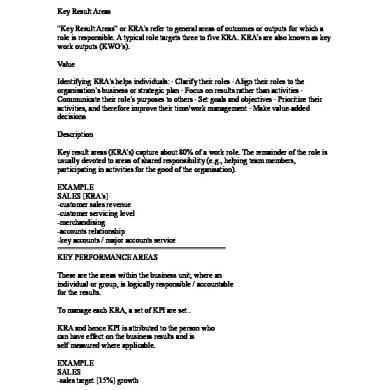Difference Between Kra And Kpa
This document was uploaded by user and they confirmed that they have the permission to share it. If you are author or own the copyright of this book, please report to us by using this DMCA report form. Report DMCA
Overview
Download & View Difference Between Kra And Kpa as PDF for free.
More details
- Words: 243
- Pages: 2
KRA AND KPA Key Result Areas “Key Result Areas” or KRA’s refer to general areas of outcomes or outputs for which a role is responsible. A typical role targets three to five KRA. KRA’s are also known as key work outputs (KWO’s). Value Identifying KRA’s helps individuals: · Clarify their roles · Align their roles to the organisation’s business or strategic plan · Focus on results rather than activities · Communicate their role’s purposes to others · Set goals and objectives · Prioritize their activities, and therefore improve their time/work management · Make value-added decisions Description Key result areas (KRA’s) capture about 80% of a work role. The remainder of the role is usually devoted to areas of shared responsibility (e.g., helping team members, participating in activities for the good of the organisation). EXAMPLE SALES [KRA’s] -customer sales revenue -customer servicing level -merchandising -accounts relationship -key accounts / major accounts service ======================================= KEY PERFORMANCE AREAS These are the areas within the business unit, where an individual or group, is logically responsible / accountable for the results. To manage each KRA, a set of KPI are set . KRA and hence KPI is attributed to the person who can have effect on the business results and is self measured where applicable. EXAMPLE SALES -sales target [15%] growth
CUSTOMER SERVICE -raise service index by 6% WAREHOUSING -improve picking/ packing rate by 7% You can have many KRA’s / KPI’s but 3/5 is workable at best.
CUSTOMER SERVICE -raise service index by 6% WAREHOUSING -improve picking/ packing rate by 7% You can have many KRA’s / KPI’s but 3/5 is workable at best.
Related Documents

Difference Between Kra And Kpa
October 2019 23
Difference Between Linux And Windows
November 2019 36
Difference Between Gpa And Spa.pdf
May 2020 9
Difference Between Jit And Traditional
May 2020 9
Difference Between Qarun And Winrunner
November 2019 18